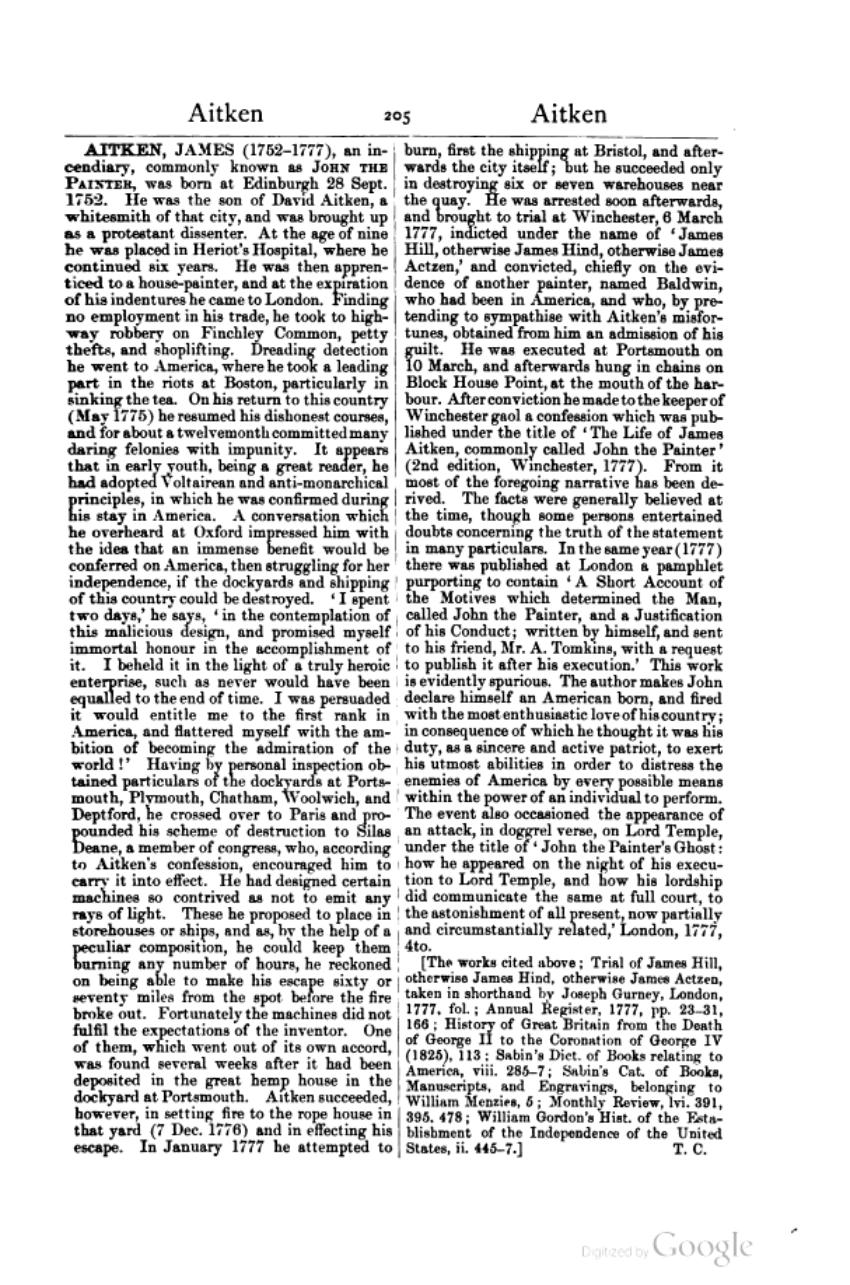AITKEN, JAMES (1752–1777), an incendiary, commonly known as John the Painter, was born at Edinburgh 28 Sept. 1752. He was the son of David Aitken, a whitesmith of that city, and was brought up as a protestant dissenter. At the age of nine he was placed in Heriot's Hospital, where he continued six years. He was then apprenticed to a house-painter, and at the expiration of his indentures he came to London. Finding no employment in his trade, he took to highway robbery on Finchley Common, petty thefts, and shoplifting. Dreading detection he went to America, where he took a leading part in the riots at Boston, particularly in sinking the tea. On his return to this country (May 1775) he resumed his dishonest courses, and for about a twelvemonth committed many daring felonies with impunity. It appears that in early youth, being a great reader, he had adopted Voltairean and anti-monarchical principles, in which he was confirmed during his stay in America. A conversation which he overheard at Oxford impressed him with the idea that an immense benefit would be conferred on America, then struggling for her independence, if the dockyards and shipping of this country could be destroyed. 'I spent two days,' he says, 'in the contemplation of this malicious design, and promised myself immortal honour in the accomplishment of it. I beheld it in the light of a truly heroic enterprise, such as never would have been equalled to the end of time. I was persuaded it would entitle me to the first rank in America, and flattered myself with the ambition of becoming the admiration of the world!' Having by personal inspection obtained particulars of the dockyards at Portsmouth, Plymouth, Chatham, Woolwich, and Deptford, he crossed over to Paris and propounded his scheme of destruction to Silas Deane, a member of congress, who, according to Aitken's confession, encouraged him to carry it into effect. He had designed certain machines so contrived as not to emit any rays of light. These he proposed to place in storehouses or ships, and as, by the help of a peculiar composition, he could keep them burning any number of hours, he reckoned on being able to make his escape sixty or seventy miles from the spot before the fire broke out. Fortunately the machines did not fulfil the expectations of the inventor. One of them, which went out of its own accord, was found several weeks after it had been deposited in the great hemp house in the dockyard at Portsmouth. Aitken succeeded, however, in setting fire to the rope house in that yard (7 Dec. 1776) and in effecting his escape. In January 1777 he attempted to burn, first the shipping at Bristol, and afterwards the city itself; but he succeeded only in destroying six or seven warehouses near the quay. He was arrested soon afterwards, and brought to trial at Winchester, 6 March 1777, indicted under the name of 'James Hill, otherwise James Hind, otherwise James Actzen,' and convicted, chiefly on the evidence of another painter, named Baldwin, who had been in America, and who, by pretending to sympathise with Aitken's misfortunes, obtained from him an admission of his guilt. He was executed at Portsmouth on 10 March, and afterwards hung in chains on Block House Point, at the mouth of the harbour. After conviction he made to the keeper of Winchester gaol a confession which was published under the title of 'The Life of James Aitken, commonly called John the Painter' (2nd edition, Winchester, 1777). From it most of the foregoing narrative has been derived. The facts were generally believed at the time, though some persons entertained doubts concerning the truth of the statement in many particulars. In the same year (1777) there was published at London a pamphlet purporting to contain 'A Short Account of the Motives which determined the Man, called John the Painter, and a Justification of his Conduct; written by himself, and sent to his friend, Mr. A. Tomkins, with a request to publish it after his execution.' This work is evidently spurious. The author makes John declare himself an American born, and fired with the most enthusiastic love of his country; in consequence of which he thought it was his duty, as a sincere and active patriot, to exert his utmost abilities in order to distress the enemies of America by every possible means within the power of an individual to perform. The event also occasioned the appearance of an attack, in doggrel verse, on Lord Temple, under the title of 'John the Painter's Ghost: how he appeared on the night of his execution to Lord Temple, and how his lordship did communicate the same at full court, to the astonishment of all present, now partially and circumstantially related,' London, 1777, 4to.
[The works cited above; Trial of James Hill, otherwise James Hind, otherwise James Actzen, taken in shorthand by Joseph Gurney, London, 1777, fol.; Annual Register, 1777, pp. 23–31, 166; History of Great Britain from the Death of George II to the Coronation of George IV (1825), 113; Sabin's Dict. of Books relating to America, viii. 285–7; Sabin's Cat. of Books, Manuscripts, and Engravings, belonging to William Menzies, 5; Monthly Review, lvi. 391, 395, 478; William Gordon's Hist. of the Establishment of the Independence of the United States, ii. 445–7.]
